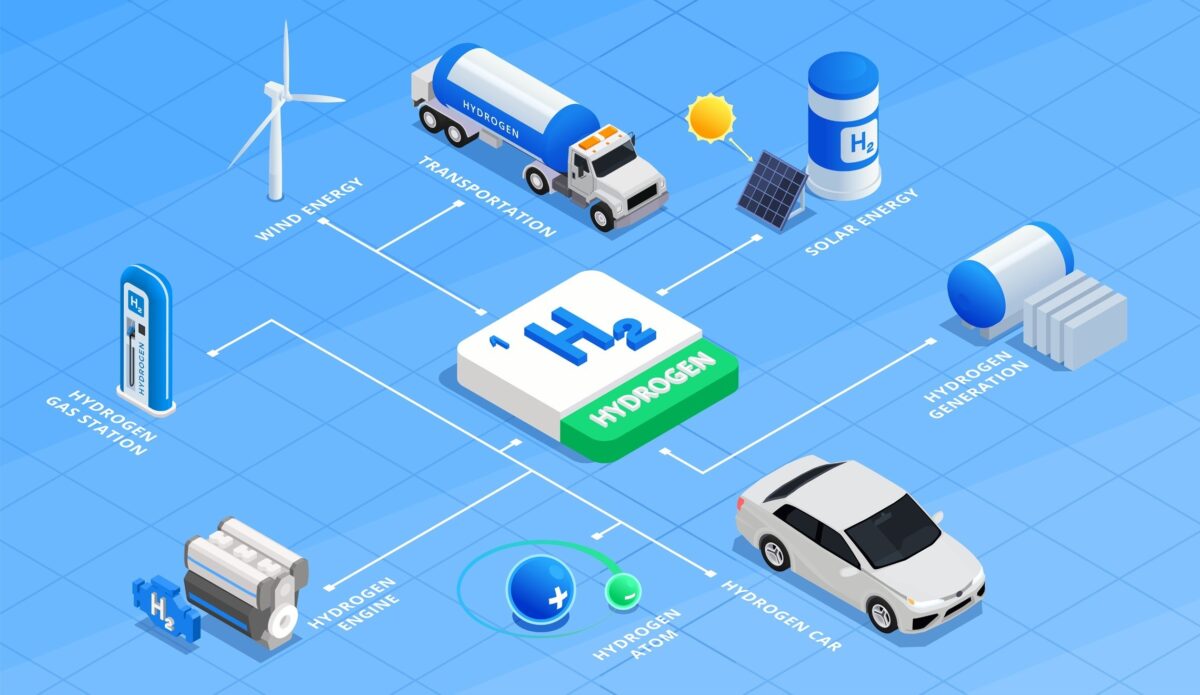Hydrogen fuel cells generate electricity through an electro-chemical reaction between hydrogen and oxygen, emitting only water and heat. Their high efficiency, modular design and ability to operate at a wide range of scales are driving adoption in transport, logistics, stationary power and, increasingly, aviation.
How a fuel cell works
A polymer-electrolyte membrane (PEM) fuel cell splits hydrogen at the anode; protons cross a proton-conducting membrane while electrons travel an external circuit to do useful work before recombining with oxygen at the cathode to form water. One cell yields about 0.7 V, so hundreds are stacked for kilowatt- to megawatt-level output. Current PEM stacks operate near 60 % electrical efficiency and meet—often exceed—the U.S. DOE’s 30 000-hour durability target. (For background on sourcing low-carbon feedstock, see our earlier article on the hydrogen colour palette and green hydrogen.)
Key technical milestones in 2025
In April 2025, University of California Los Angeles researchers reported catalyst and support changes that extended PEM stack life beyond 200 000 hours, a seven-fold jump over the DOE benchmark for heavy-duty vehicles. Bloom Energy’s newest solid-oxide “Server 6.5” modules deliver 325 kW at 65 % electrical efficiency, pushing its installed base past 1.2 GW across eight countries.
Application highlights across sectors
Rail – Sierra Northern Railway, California
According to Ballard Power Systems, Sierra Northern is refitting three diesel switcher locomotives with twelve FCmove-HD+ fuel-cell engines, each rated at 200 kW, for a combined output of 1.5 MW. The first prototype completed pilot runs in early 2025 on yard-duty cycles that demand high torque but limited range—a profile well-suited to hydrogen refuelling at a central depot. Project sponsors estimate annual CO₂ savings of roughly 640 t once the fleet is fully operational.
Aviation – Airbus and MTU Aero Engines roadmap
A June 2025 joint statement from Airbus and MTU details a three-phase programme to develop a multi-megawatt fuel-cell powertrain able to propel a 40-to-80-seat regional aircraft. The partners plan ground testing by 2027, flight demonstrations by 2030 and potential product launch soon after, contingent on cryogenic hydrogen infrastructure at airports. Airbus engineers cite fuel-cell electric propulsion as a complement to the manufacturer’s “ZEROe” hydrogen-combustion concept, particularly on shorter routes where noise and local-emission limits are tightening.
Material-handling – STEF cold-storage logistics, Europe
Cold-chain specialist STEF announced in April 2025 that it will deploy 115 Toyota Material Handling forklifts equipped with Plug Power GenDrive fuel-cell packs across distribution centres in France and Spain. Forklifts in refrigerated warehouses operate continuously and cannot tolerate battery-charging downtime; hydrogen refuelling takes under three minutes and maintains full performance in sub-zero environments. An on-site electrolyser at the Madrid hub will supply green hydrogen, supporting STEF’s goal of sourcing all facility energy from low-carbon sources by the end of 2025.
Stationary power – Bloom Energy solid-oxide systems
Bloom Energy reports that its solid-oxide fuel-cell fleet passed 1.2 GW of cumulative installed capacity in 2025. Each Server 6.5 module provides 325 kW at 65 % electrical efficiency when operated on hydrogen, and more than 53 % when running on natural gas. Installations during the past year include data-centre clusters in California and microgrids for hospitals in South Korea, where uninterrupted power and strict emission limits are critical.
Implications for industry decision-makers
Longer stack life and higher efficiency—exemplified by UCLA’s 200 000-hour result and Bloom’s 65 % modules—cut fuel and replacement costs, improving competitiveness for long-haul trucking, logistics hubs and critical-power sites. Field projects in rail, forklifts and emerging aviation platforms also show that pairing on-site electrolysers with fuel-cell assets can secure supply and advance Scope 3 decarbonisation goals. Airports, in particular, must start planning cryogenic hydrogen handling this decade to align with Airbus–MTU timelines. With technical gains and green-hydrogen infrastructure advancing in parallel, fuel cells are positioned for broader commercial deployment through 2030.

